Critical Appraisal of Article
VerifiedAdded on 2023/04/20
|10
|2111
|232
AI Summary
In this essay, a study of randomized control trial study is criticized. The study evaluated the effectiveness of the nursing practitioners in giving analgesics within time among the patients having severe pain.
Contribute Materials
Your contribution can guide someone’s learning journey. Share your
documents today.

Running head: CRITICAL APPRAISAL OF ARTICLE
Critical Appraisal of Article
Name of the Student
Name of the University
Author Note
Critical Appraisal of Article
Name of the Student
Name of the University
Author Note
Secure Best Marks with AI Grader
Need help grading? Try our AI Grader for instant feedback on your assignments.
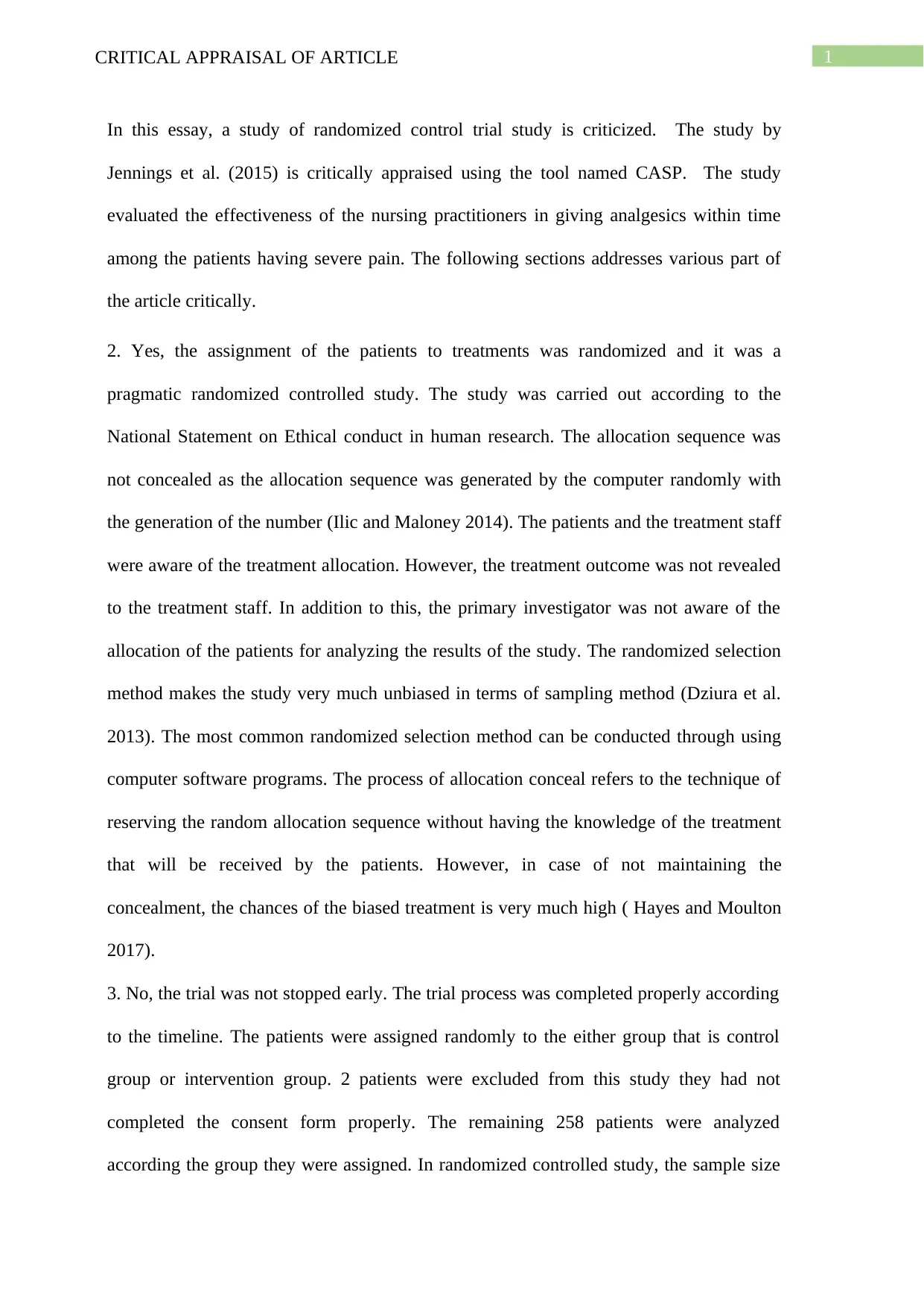
1CRITICAL APPRAISAL OF ARTICLE
In this essay, a study of randomized control trial study is criticized. The study by
Jennings et al. (2015) is critically appraised using the tool named CASP. The study
evaluated the effectiveness of the nursing practitioners in giving analgesics within time
among the patients having severe pain. The following sections addresses various part of
the article critically.
2. Yes, the assignment of the patients to treatments was randomized and it was a
pragmatic randomized controlled study. The study was carried out according to the
National Statement on Ethical conduct in human research. The allocation sequence was
not concealed as the allocation sequence was generated by the computer randomly with
the generation of the number (Ilic and Maloney 2014). The patients and the treatment staff
were aware of the treatment allocation. However, the treatment outcome was not revealed
to the treatment staff. In addition to this, the primary investigator was not aware of the
allocation of the patients for analyzing the results of the study. The randomized selection
method makes the study very much unbiased in terms of sampling method (Dziura et al.
2013). The most common randomized selection method can be conducted through using
computer software programs. The process of allocation conceal refers to the technique of
reserving the random allocation sequence without having the knowledge of the treatment
that will be received by the patients. However, in case of not maintaining the
concealment, the chances of the biased treatment is very much high ( Hayes and Moulton
2017).
3. No, the trial was not stopped early. The trial process was completed properly according
to the timeline. The patients were assigned randomly to the either group that is control
group or intervention group. 2 patients were excluded from this study they had not
completed the consent form properly. The remaining 258 patients were analyzed
according the group they were assigned. In randomized controlled study, the sample size
In this essay, a study of randomized control trial study is criticized. The study by
Jennings et al. (2015) is critically appraised using the tool named CASP. The study
evaluated the effectiveness of the nursing practitioners in giving analgesics within time
among the patients having severe pain. The following sections addresses various part of
the article critically.
2. Yes, the assignment of the patients to treatments was randomized and it was a
pragmatic randomized controlled study. The study was carried out according to the
National Statement on Ethical conduct in human research. The allocation sequence was
not concealed as the allocation sequence was generated by the computer randomly with
the generation of the number (Ilic and Maloney 2014). The patients and the treatment staff
were aware of the treatment allocation. However, the treatment outcome was not revealed
to the treatment staff. In addition to this, the primary investigator was not aware of the
allocation of the patients for analyzing the results of the study. The randomized selection
method makes the study very much unbiased in terms of sampling method (Dziura et al.
2013). The most common randomized selection method can be conducted through using
computer software programs. The process of allocation conceal refers to the technique of
reserving the random allocation sequence without having the knowledge of the treatment
that will be received by the patients. However, in case of not maintaining the
concealment, the chances of the biased treatment is very much high ( Hayes and Moulton
2017).
3. No, the trial was not stopped early. The trial process was completed properly according
to the timeline. The patients were assigned randomly to the either group that is control
group or intervention group. 2 patients were excluded from this study they had not
completed the consent form properly. The remaining 258 patients were analyzed
according the group they were assigned. In randomized controlled study, the sample size
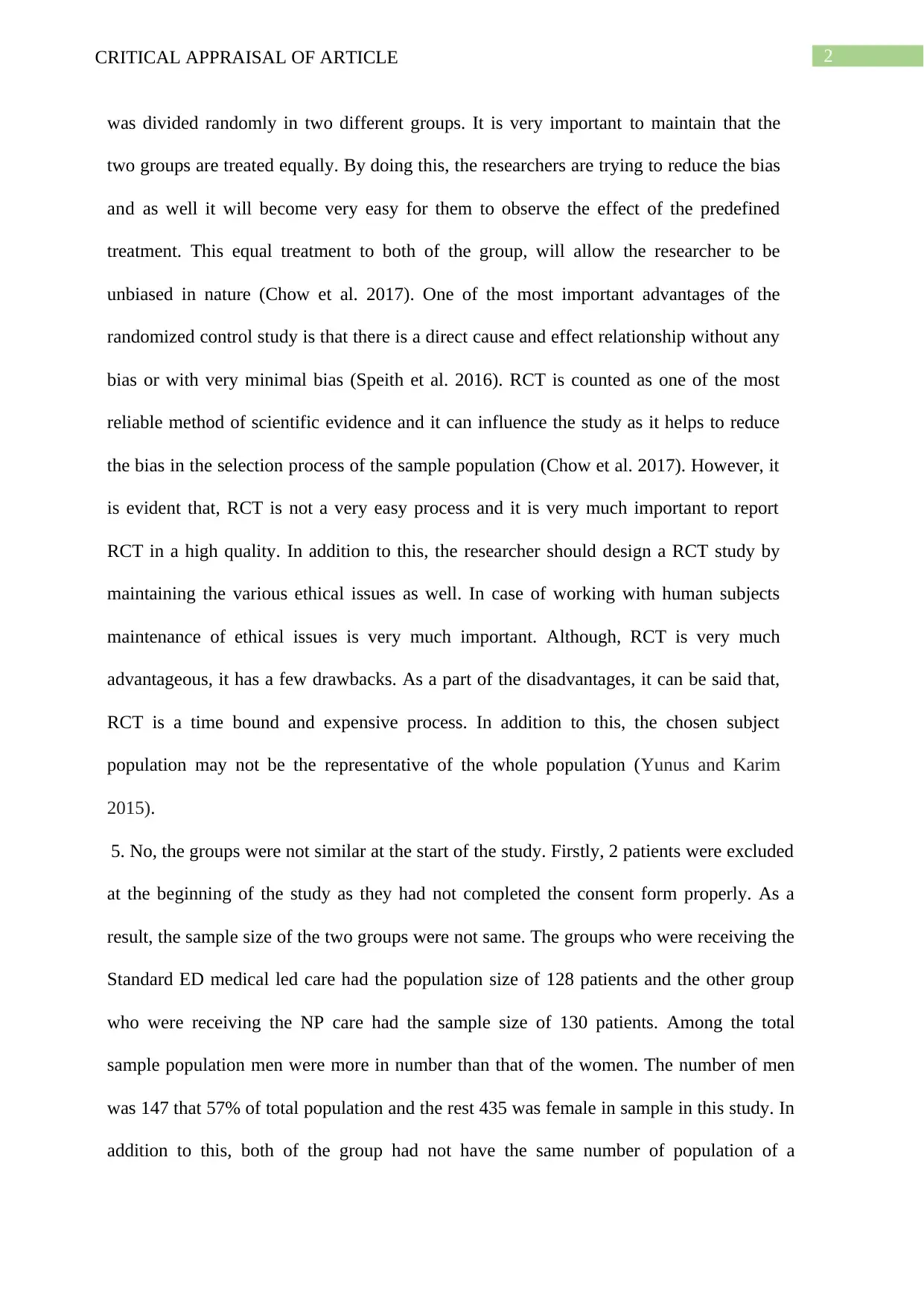
2CRITICAL APPRAISAL OF ARTICLE
was divided randomly in two different groups. It is very important to maintain that the
two groups are treated equally. By doing this, the researchers are trying to reduce the bias
and as well it will become very easy for them to observe the effect of the predefined
treatment. This equal treatment to both of the group, will allow the researcher to be
unbiased in nature (Chow et al. 2017). One of the most important advantages of the
randomized control study is that there is a direct cause and effect relationship without any
bias or with very minimal bias (Speith et al. 2016). RCT is counted as one of the most
reliable method of scientific evidence and it can influence the study as it helps to reduce
the bias in the selection process of the sample population (Chow et al. 2017). However, it
is evident that, RCT is not a very easy process and it is very much important to report
RCT in a high quality. In addition to this, the researcher should design a RCT study by
maintaining the various ethical issues as well. In case of working with human subjects
maintenance of ethical issues is very much important. Although, RCT is very much
advantageous, it has a few drawbacks. As a part of the disadvantages, it can be said that,
RCT is a time bound and expensive process. In addition to this, the chosen subject
population may not be the representative of the whole population (Yunus and Karim
2015).
5. No, the groups were not similar at the start of the study. Firstly, 2 patients were excluded
at the beginning of the study as they had not completed the consent form properly. As a
result, the sample size of the two groups were not same. The groups who were receiving the
Standard ED medical led care had the population size of 128 patients and the other group
who were receiving the NP care had the sample size of 130 patients. Among the total
sample population men were more in number than that of the women. The number of men
was 147 that 57% of total population and the rest 435 was female in sample in this study. In
addition to this, both of the group had not have the same number of population of a
was divided randomly in two different groups. It is very important to maintain that the
two groups are treated equally. By doing this, the researchers are trying to reduce the bias
and as well it will become very easy for them to observe the effect of the predefined
treatment. This equal treatment to both of the group, will allow the researcher to be
unbiased in nature (Chow et al. 2017). One of the most important advantages of the
randomized control study is that there is a direct cause and effect relationship without any
bias or with very minimal bias (Speith et al. 2016). RCT is counted as one of the most
reliable method of scientific evidence and it can influence the study as it helps to reduce
the bias in the selection process of the sample population (Chow et al. 2017). However, it
is evident that, RCT is not a very easy process and it is very much important to report
RCT in a high quality. In addition to this, the researcher should design a RCT study by
maintaining the various ethical issues as well. In case of working with human subjects
maintenance of ethical issues is very much important. Although, RCT is very much
advantageous, it has a few drawbacks. As a part of the disadvantages, it can be said that,
RCT is a time bound and expensive process. In addition to this, the chosen subject
population may not be the representative of the whole population (Yunus and Karim
2015).
5. No, the groups were not similar at the start of the study. Firstly, 2 patients were excluded
at the beginning of the study as they had not completed the consent form properly. As a
result, the sample size of the two groups were not same. The groups who were receiving the
Standard ED medical led care had the population size of 128 patients and the other group
who were receiving the NP care had the sample size of 130 patients. Among the total
sample population men were more in number than that of the women. The number of men
was 147 that 57% of total population and the rest 435 was female in sample in this study. In
addition to this, both of the group had not have the same number of population of a
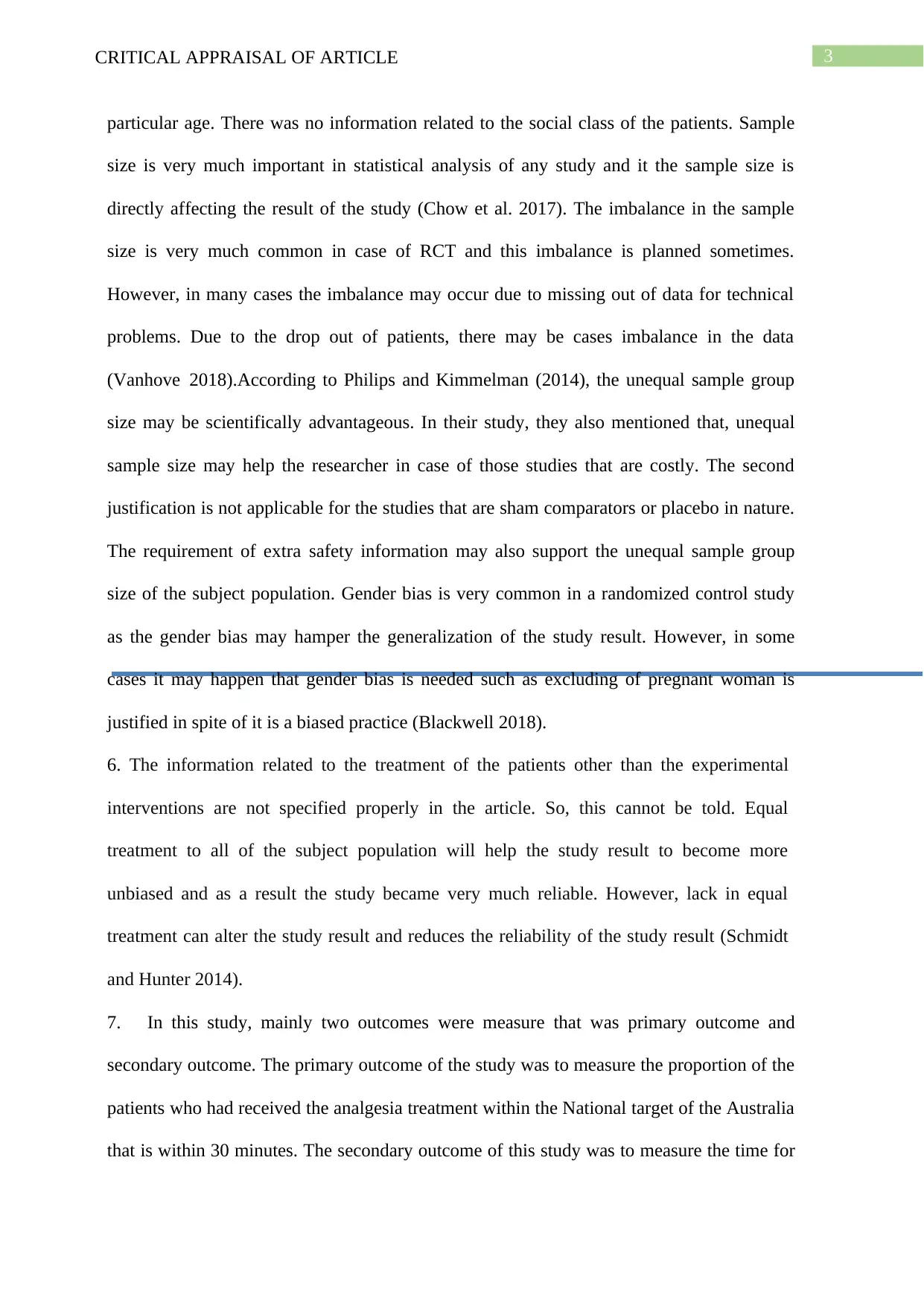
3CRITICAL APPRAISAL OF ARTICLE
particular age. There was no information related to the social class of the patients. Sample
size is very much important in statistical analysis of any study and it the sample size is
directly affecting the result of the study (Chow et al. 2017). The imbalance in the sample
size is very much common in case of RCT and this imbalance is planned sometimes.
However, in many cases the imbalance may occur due to missing out of data for technical
problems. Due to the drop out of patients, there may be cases imbalance in the data
(Vanhove 2018).According to Philips and Kimmelman (2014), the unequal sample group
size may be scientifically advantageous. In their study, they also mentioned that, unequal
sample size may help the researcher in case of those studies that are costly. The second
justification is not applicable for the studies that are sham comparators or placebo in nature.
The requirement of extra safety information may also support the unequal sample group
size of the subject population. Gender bias is very common in a randomized control study
as the gender bias may hamper the generalization of the study result. However, in some
cases it may happen that gender bias is needed such as excluding of pregnant woman is
justified in spite of it is a biased practice (Blackwell 2018).
6. The information related to the treatment of the patients other than the experimental
interventions are not specified properly in the article. So, this cannot be told. Equal
treatment to all of the subject population will help the study result to become more
unbiased and as a result the study became very much reliable. However, lack in equal
treatment can alter the study result and reduces the reliability of the study result (Schmidt
and Hunter 2014).
7. In this study, mainly two outcomes were measure that was primary outcome and
secondary outcome. The primary outcome of the study was to measure the proportion of the
patients who had received the analgesia treatment within the National target of the Australia
that is within 30 minutes. The secondary outcome of this study was to measure the time for
particular age. There was no information related to the social class of the patients. Sample
size is very much important in statistical analysis of any study and it the sample size is
directly affecting the result of the study (Chow et al. 2017). The imbalance in the sample
size is very much common in case of RCT and this imbalance is planned sometimes.
However, in many cases the imbalance may occur due to missing out of data for technical
problems. Due to the drop out of patients, there may be cases imbalance in the data
(Vanhove 2018).According to Philips and Kimmelman (2014), the unequal sample group
size may be scientifically advantageous. In their study, they also mentioned that, unequal
sample size may help the researcher in case of those studies that are costly. The second
justification is not applicable for the studies that are sham comparators or placebo in nature.
The requirement of extra safety information may also support the unequal sample group
size of the subject population. Gender bias is very common in a randomized control study
as the gender bias may hamper the generalization of the study result. However, in some
cases it may happen that gender bias is needed such as excluding of pregnant woman is
justified in spite of it is a biased practice (Blackwell 2018).
6. The information related to the treatment of the patients other than the experimental
interventions are not specified properly in the article. So, this cannot be told. Equal
treatment to all of the subject population will help the study result to become more
unbiased and as a result the study became very much reliable. However, lack in equal
treatment can alter the study result and reduces the reliability of the study result (Schmidt
and Hunter 2014).
7. In this study, mainly two outcomes were measure that was primary outcome and
secondary outcome. The primary outcome of the study was to measure the proportion of the
patients who had received the analgesia treatment within the National target of the Australia
that is within 30 minutes. The secondary outcome of this study was to measure the time for
Secure Best Marks with AI Grader
Need help grading? Try our AI Grader for instant feedback on your assignments.
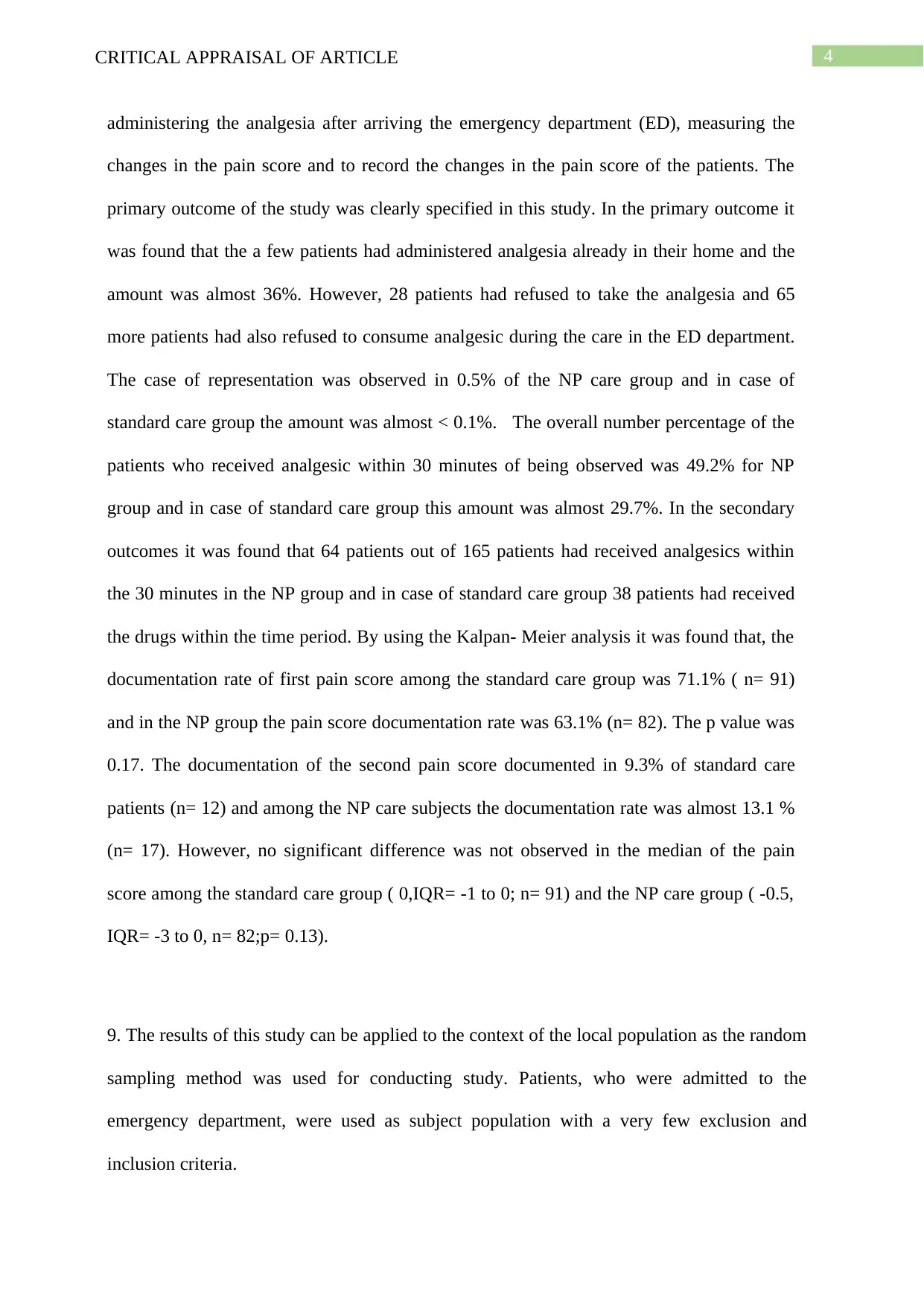
4CRITICAL APPRAISAL OF ARTICLE
administering the analgesia after arriving the emergency department (ED), measuring the
changes in the pain score and to record the changes in the pain score of the patients. The
primary outcome of the study was clearly specified in this study. In the primary outcome it
was found that the a few patients had administered analgesia already in their home and the
amount was almost 36%. However, 28 patients had refused to take the analgesia and 65
more patients had also refused to consume analgesic during the care in the ED department.
The case of representation was observed in 0.5% of the NP care group and in case of
standard care group the amount was almost < 0.1%. The overall number percentage of the
patients who received analgesic within 30 minutes of being observed was 49.2% for NP
group and in case of standard care group this amount was almost 29.7%. In the secondary
outcomes it was found that 64 patients out of 165 patients had received analgesics within
the 30 minutes in the NP group and in case of standard care group 38 patients had received
the drugs within the time period. By using the Kalpan- Meier analysis it was found that, the
documentation rate of first pain score among the standard care group was 71.1% ( n= 91)
and in the NP group the pain score documentation rate was 63.1% (n= 82). The p value was
0.17. The documentation of the second pain score documented in 9.3% of standard care
patients (n= 12) and among the NP care subjects the documentation rate was almost 13.1 %
(n= 17). However, no significant difference was not observed in the median of the pain
score among the standard care group ( 0,IQR= -1 to 0; n= 91) and the NP care group ( -0.5,
IQR= -3 to 0, n= 82;p= 0.13).
9. The results of this study can be applied to the context of the local population as the random
sampling method was used for conducting study. Patients, who were admitted to the
emergency department, were used as subject population with a very few exclusion and
inclusion criteria.
administering the analgesia after arriving the emergency department (ED), measuring the
changes in the pain score and to record the changes in the pain score of the patients. The
primary outcome of the study was clearly specified in this study. In the primary outcome it
was found that the a few patients had administered analgesia already in their home and the
amount was almost 36%. However, 28 patients had refused to take the analgesia and 65
more patients had also refused to consume analgesic during the care in the ED department.
The case of representation was observed in 0.5% of the NP care group and in case of
standard care group the amount was almost < 0.1%. The overall number percentage of the
patients who received analgesic within 30 minutes of being observed was 49.2% for NP
group and in case of standard care group this amount was almost 29.7%. In the secondary
outcomes it was found that 64 patients out of 165 patients had received analgesics within
the 30 minutes in the NP group and in case of standard care group 38 patients had received
the drugs within the time period. By using the Kalpan- Meier analysis it was found that, the
documentation rate of first pain score among the standard care group was 71.1% ( n= 91)
and in the NP group the pain score documentation rate was 63.1% (n= 82). The p value was
0.17. The documentation of the second pain score documented in 9.3% of standard care
patients (n= 12) and among the NP care subjects the documentation rate was almost 13.1 %
(n= 17). However, no significant difference was not observed in the median of the pain
score among the standard care group ( 0,IQR= -1 to 0; n= 91) and the NP care group ( -0.5,
IQR= -3 to 0, n= 82;p= 0.13).
9. The results of this study can be applied to the context of the local population as the random
sampling method was used for conducting study. Patients, who were admitted to the
emergency department, were used as subject population with a very few exclusion and
inclusion criteria.
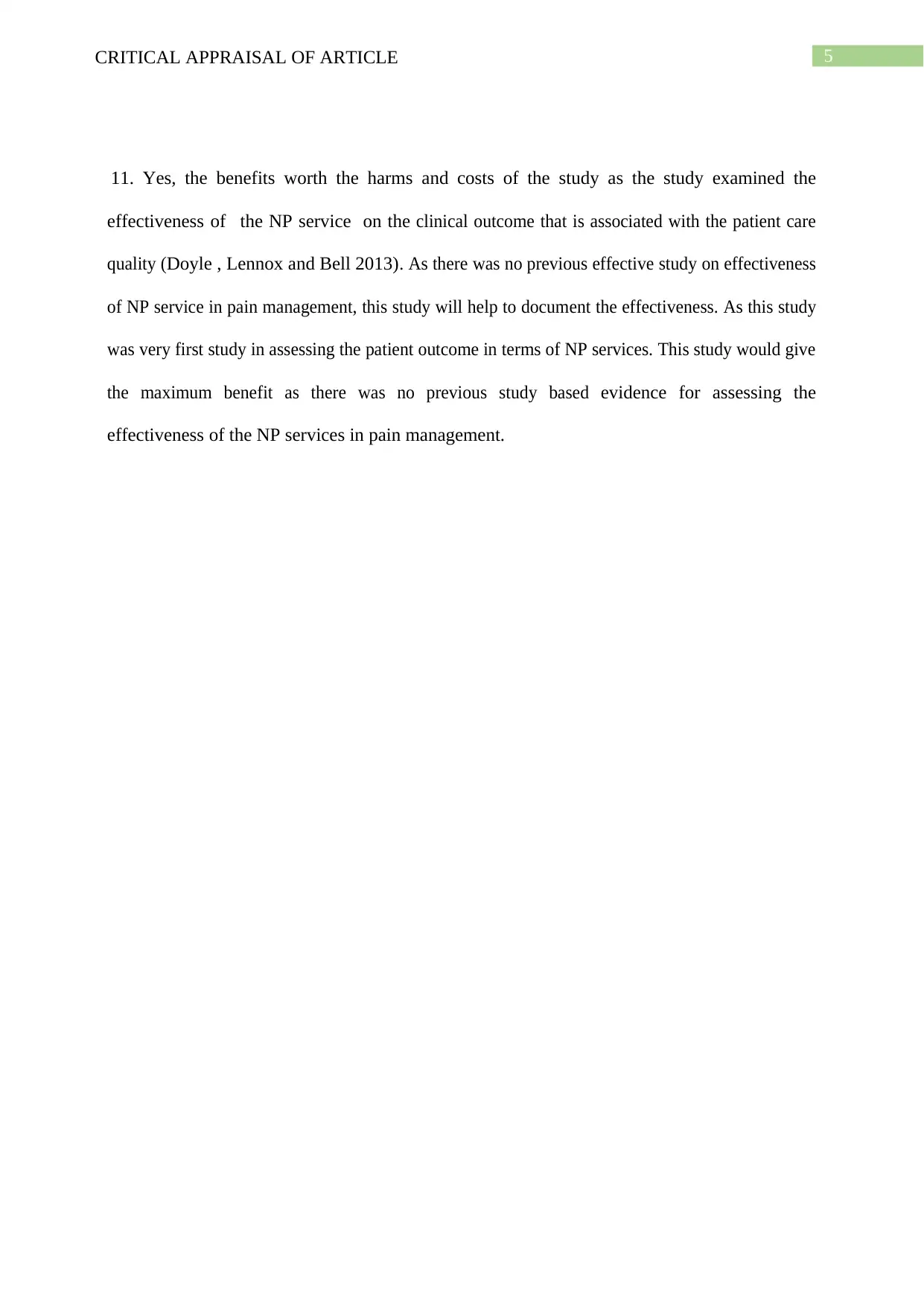
5CRITICAL APPRAISAL OF ARTICLE
11. Yes, the benefits worth the harms and costs of the study as the study examined the
effectiveness of the NP service on the clinical outcome that is associated with the patient care
quality (Doyle , Lennox and Bell 2013) . As there was no previous effective study on effectiveness
of NP service in pain management, this study will help to document the effectiveness. As this study
was very first study in assessing the patient outcome in terms of NP services. This study would give
the maximum benefit as there was no previous study based evidence for assessing the
effectiveness of the NP services in pain management.
11. Yes, the benefits worth the harms and costs of the study as the study examined the
effectiveness of the NP service on the clinical outcome that is associated with the patient care
quality (Doyle , Lennox and Bell 2013) . As there was no previous effective study on effectiveness
of NP service in pain management, this study will help to document the effectiveness. As this study
was very first study in assessing the patient outcome in terms of NP services. This study would give
the maximum benefit as there was no previous study based evidence for assessing the
effectiveness of the NP services in pain management.
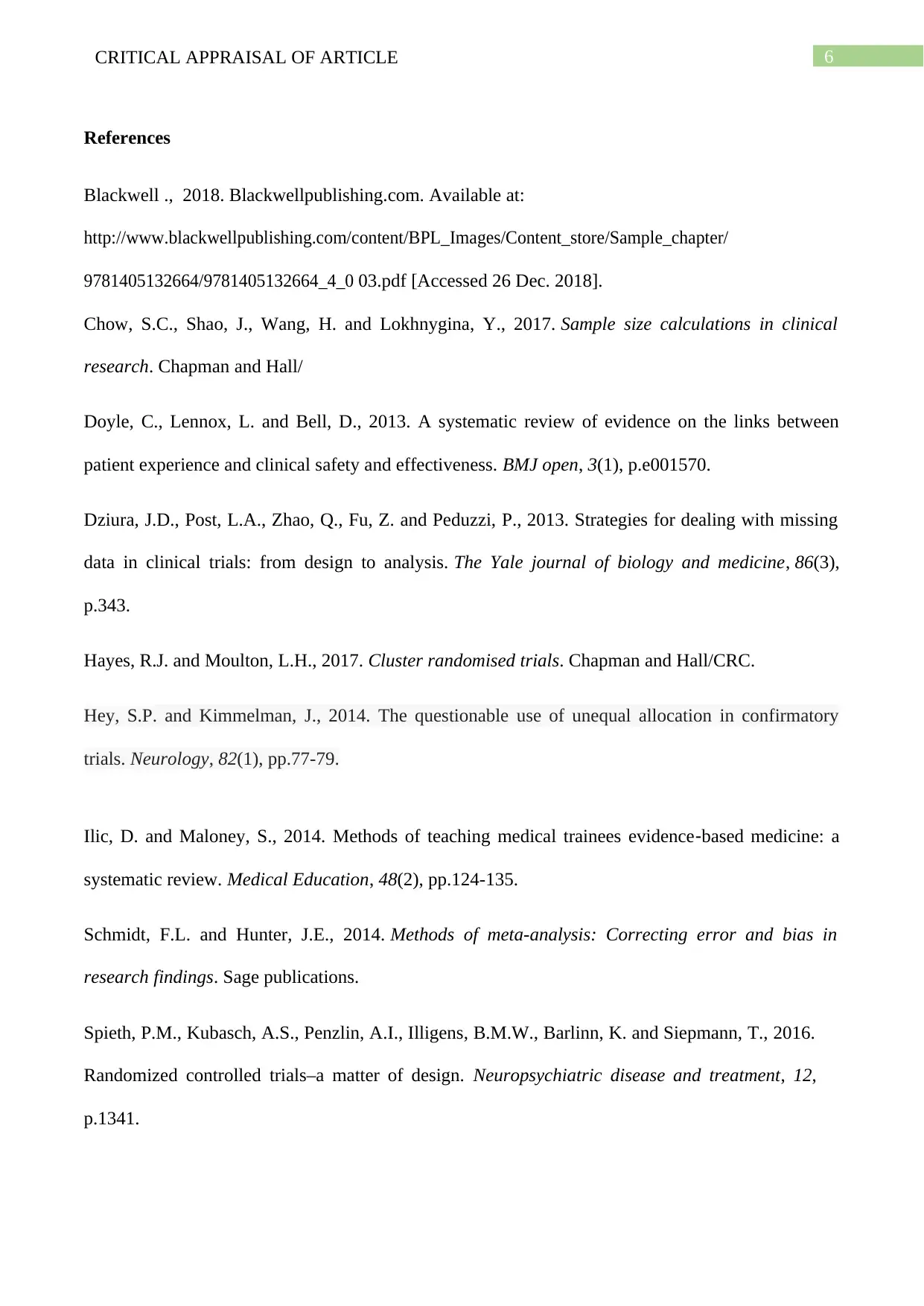
6CRITICAL APPRAISAL OF ARTICLE
References
Blackwell ., 2018. Blackwellpublishing.com. Available at:
http://www.blackwellpublishing.com/content/BPL_Images/Content_store/Sample_chapter/
9781405132664/9781405132664_4_0 03.pdf [Accessed 26 Dec. 2018].
Chow, S.C., Shao, J., Wang, H. and Lokhnygina, Y., 2017. Sample size calculations in clinical
research. Chapman and Hall/
Doyle, C., Lennox, L. and Bell, D., 2013. A systematic review of evidence on the links between
patient experience and clinical safety and effectiveness. BMJ open, 3(1), p.e001570.
Dziura, J.D., Post, L.A., Zhao, Q., Fu, Z. and Peduzzi, P., 2013. Strategies for dealing with missing
data in clinical trials: from design to analysis. The Yale journal of biology and medicine, 86(3),
p.343.
Hayes, R.J. and Moulton, L.H., 2017. Cluster randomised trials. Chapman and Hall/CRC.
Hey, S.P. and Kimmelman, J., 2014. The questionable use of unequal allocation in confirmatory
trials. Neurology, 82(1), pp.77-79.
Ilic, D. and Maloney, S., 2014. Methods of teaching medical trainees evidence‐based medicine: a
systematic review. Medical Education, 48(2), pp.124-135.
Schmidt, F.L. and Hunter, J.E., 2014. Methods of meta-analysis: Correcting error and bias in
research findings. Sage publications.
Spieth, P.M., Kubasch, A.S., Penzlin, A.I., Illigens, B.M.W., Barlinn, K. and Siepmann, T., 2016.
Randomized controlled trials–a matter of design. Neuropsychiatric disease and treatment, 12,
p.1341.
References
Blackwell ., 2018. Blackwellpublishing.com. Available at:
http://www.blackwellpublishing.com/content/BPL_Images/Content_store/Sample_chapter/
9781405132664/9781405132664_4_0 03.pdf [Accessed 26 Dec. 2018].
Chow, S.C., Shao, J., Wang, H. and Lokhnygina, Y., 2017. Sample size calculations in clinical
research. Chapman and Hall/
Doyle, C., Lennox, L. and Bell, D., 2013. A systematic review of evidence on the links between
patient experience and clinical safety and effectiveness. BMJ open, 3(1), p.e001570.
Dziura, J.D., Post, L.A., Zhao, Q., Fu, Z. and Peduzzi, P., 2013. Strategies for dealing with missing
data in clinical trials: from design to analysis. The Yale journal of biology and medicine, 86(3),
p.343.
Hayes, R.J. and Moulton, L.H., 2017. Cluster randomised trials. Chapman and Hall/CRC.
Hey, S.P. and Kimmelman, J., 2014. The questionable use of unequal allocation in confirmatory
trials. Neurology, 82(1), pp.77-79.
Ilic, D. and Maloney, S., 2014. Methods of teaching medical trainees evidence‐based medicine: a
systematic review. Medical Education, 48(2), pp.124-135.
Schmidt, F.L. and Hunter, J.E., 2014. Methods of meta-analysis: Correcting error and bias in
research findings. Sage publications.
Spieth, P.M., Kubasch, A.S., Penzlin, A.I., Illigens, B.M.W., Barlinn, K. and Siepmann, T., 2016.
Randomized controlled trials–a matter of design. Neuropsychiatric disease and treatment, 12,
p.1341.
Paraphrase This Document
Need a fresh take? Get an instant paraphrase of this document with our AI Paraphraser

7CRITICAL APPRAISAL OF ARTICLE
Vanhove, J., 2018. Jan Vanhove :: Causes and consequences of unequal sample sizes. [online]
Janhove.github.io. Available at: https://janhove.github.io/design/2015/11/02/unequal-sample-sized
[Accessed 26 Dec. 2018].
Yunus, M. and Karim, H.M.R., 2015. RANDOMIZED CONTROLLED TRIAL.
Vanhove, J., 2018. Jan Vanhove :: Causes and consequences of unequal sample sizes. [online]
Janhove.github.io. Available at: https://janhove.github.io/design/2015/11/02/unequal-sample-sized
[Accessed 26 Dec. 2018].
Yunus, M. and Karim, H.M.R., 2015. RANDOMIZED CONTROLLED TRIAL.

8CRITICAL APPRAISAL OF ARTICLE

Running head: CRITICAL APPRAISAL OF ARTICLE
1 out of 10
Related Documents
Your All-in-One AI-Powered Toolkit for Academic Success.
+13062052269
info@desklib.com
Available 24*7 on WhatsApp / Email
![[object Object]](/_next/static/media/star-bottom.7253800d.svg)
Unlock your academic potential
© 2024 | Zucol Services PVT LTD | All rights reserved.





